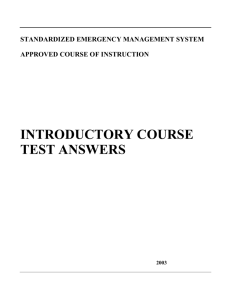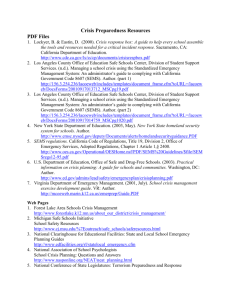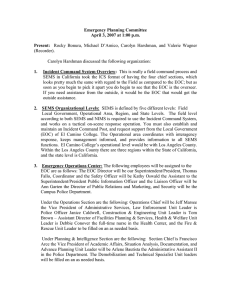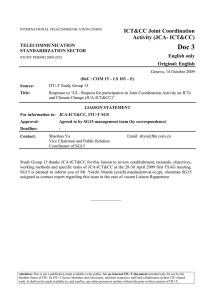Cal. Code Regs. 19-2400, et seq.doc
advertisement
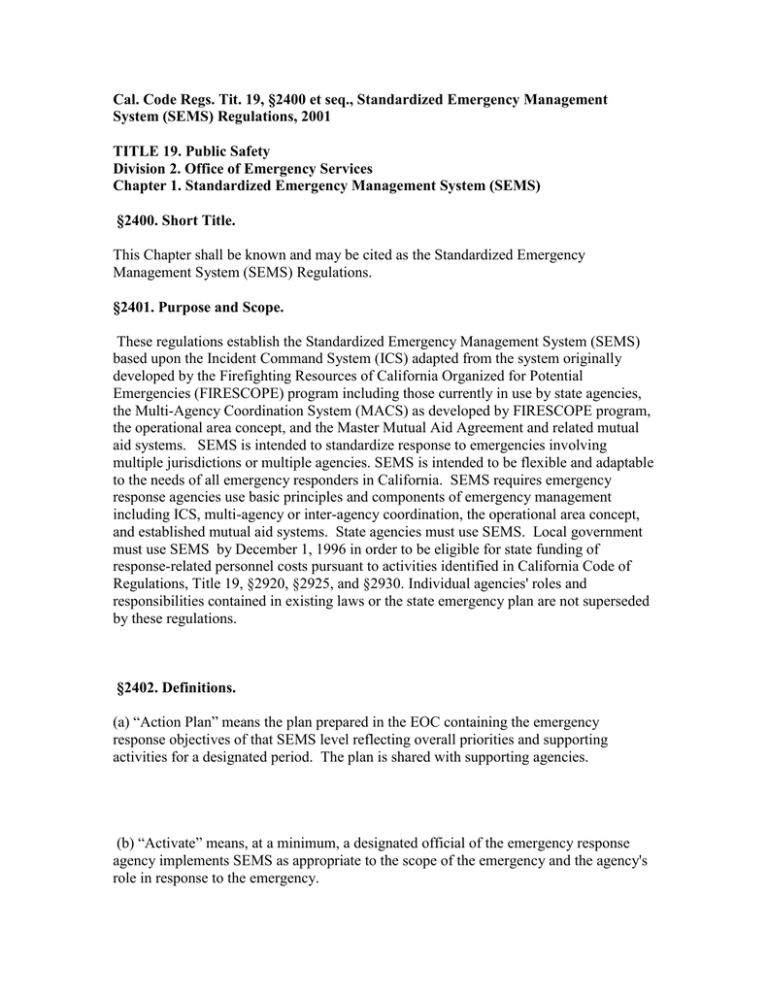
Cal. Code Regs. Tit. 19, §2400 et seq., Standardized Emergency Management System (SEMS) Regulations, 2001 TITLE 19. Public Safety Division 2. Office of Emergency Services Chapter 1. Standardized Emergency Management System (SEMS) §2400. Short Title. This Chapter shall be known and may be cited as the Standardized Emergency Management System (SEMS) Regulations. §2401. Purpose and Scope. These regulations establish the Standardized Emergency Management System (SEMS) based upon the Incident Command System (ICS) adapted from the system originally developed by the Firefighting Resources of California Organized for Potential Emergencies (FIRESCOPE) program including those currently in use by state agencies, the Multi-Agency Coordination System (MACS) as developed by FIRESCOPE program, the operational area concept, and the Master Mutual Aid Agreement and related mutual aid systems. SEMS is intended to standardize response to emergencies involving multiple jurisdictions or multiple agencies. SEMS is intended to be flexible and adaptable to the needs of all emergency responders in California. SEMS requires emergency response agencies use basic principles and components of emergency management including ICS, multi-agency or inter-agency coordination, the operational area concept, and established mutual aid systems. State agencies must use SEMS. Local government must use SEMS by December 1, 1996 in order to be eligible for state funding of response-related personnel costs pursuant to activities identified in California Code of Regulations, Title 19, §2920, §2925, and §2930. Individual agencies' roles and responsibilities contained in existing laws or the state emergency plan are not superseded by these regulations. §2402. Definitions. (a) “Action Plan” means the plan prepared in the EOC containing the emergency response objectives of that SEMS level reflecting overall priorities and supporting activities for a designated period. The plan is shared with supporting agencies. (b) “Activate” means, at a minimum, a designated official of the emergency response agency implements SEMS as appropriate to the scope of the emergency and the agency's role in response to the emergency. (c) “Department Operations Center” means an EOC used by a district discipline (such as flood operations, fire, medical, hazardous material), or a unit (such as Department of Public Works or Department of Health). Department operations centers may be used at all SEMS levels above the field response level depending upon the impacts of the emergency. (d) “Disaster Assistance Program” is a program that provides state funding or reimbursement for local government response-related personnel costs incurred in response to an incident as defined in Section 2402(i). (e) “Emergency” means a condition of disaster or of extreme peril to the safety of persons and property caused by such conditions as air pollution, fire, flood, hazardous material incident, storm, epidemic, riot, drought, sudden and severe energy shortage, plant or animal infestations or disease, the Governor's warning of an earthquake or volcanic prediction, or an earthquake or other conditions, other than conditions resulting from a labor controversy. (f) “Emergency Operations Center (EOC)” means a location from which centralized emergency management can be performed. (g) “Emergency Response Agency” means any organization responding to an emergency, or providing mutual aid support to such an organization, whether in the field, at the scene of an incident, or to an operations center. (h) “Emergency Response Personnel” means personnel involved with an agency's response to an emergency. (i) “Incident” means an occurrence or event, either human-caused or by natural phenomena, that requires action by emergency response personnel to prevent or minimize loss of life or damage to property and/or natural resources. (j) “Incident Action Plan” means the plan developed at the field response level which contains objectives reflecting the overall incident strategy and specific tactical actions and supporting information for the next operational period. The plan may be oral or written. (k) “Incident Commander” means the individual responsible for the command of all functions at the field response level. (l) “Incident Command System (ICS)” means the nationally used standardized on-scene emergency management concept specifically designed to allow its user(s) to adopt an integrated organizational structure equal to the complexity and demands of single or multiple incidents without being hindered by jurisdictional boundaries. ICS is the combination of facilities, equipment, personnel, procedures, and communications operating within a common organizational structure, with responsibility for the management of resources to effectively accomplish stated objectives pertinent to an incident. (m) “Local Government” means local agencies as defined in Government Code §8680.2 and special districts defined in California Code of Regulations, Title 19, §2900(y). (n) “Multi-agency or interagency coordination” means the participation of agencies and disciplines involved at any level of the SEMS organization working together in a coordinated effort to facilitate decisions for overall emergency response activities, including the sharing of critical resources and the prioritization of incidents. (o) “Office of Emergency Services (OES)” means the Governor's Office of Emergency Services. §2403. SEMS Organizational Levels and Functions. (a) All emergency response agencies shall use the Standardized Emergency Management System in responding to, managing, and coordinating multiple agency or multiple jurisdiction incidents, whether single or multiple discipline. (b) There are five designated levels in the SEMS organization: field response, local government, operational area, regional, and state. Each level is activated as needed. (1) “Field response level” commands emergency response personnel and resources to carry out tactical decisions and activities in direct response to an incident or threat. (2) “Local government level” manages and coordinates the overall emergency response and recovery activities within their jurisdiction. (3) “Operational area level” manages and/or coordinates information, resources, and priorities among local governments within the operational area and serves as the coordination and communication link between the local government level and the regional level. (4) “Regional level” manages and coordinates information and resources among operational areas within the mutual aid region designated pursuant to Government Code §8600 and between the operational areas and the state level. This level along with the state level coordinates overall state agency support for emergency response activities. (5) “State level” manages state resources in response to the emergency needs of the other levels, manages and coordinates mutual aid among the mutual aid regions and between the regional level and state level, and serves as the coordination and communication link with the federal disaster response system. (c) Local government, operational area, regional, and state levels shall provide for all of the following functions within SEMS: management, operations, planning/intelligence, logistics, and finance/administration. (1) Management is responsible for overall emergency policy and coordination through the joint efforts of governmental agencies and private organizations. (2) Operations is responsible for coordinating all jurisdictional operations in support of the response to the emergency through implementation of the organizational level's action plan. (3) Planning/Intelligence is responsible for collecting, evaluating, and disseminating information; developing the organizational level's action plan in coordination with the other functions; and maintaining documentation. (4) Logistics is responsible for providing facilities, services, personnel, equipment, and materials. (5) Finance/Administration is responsible for financial activities and administrative aspects not assigned to the other functions. §2403. SEMS Organizational Levels and Functions. (a) All emergency response agencies shall use the Standardized Emergency Management System in responding to, managing, and coordinating multiple agency or multiple jurisdiction incidents, whether single or multiple discipline. (b) There are five designated levels in the SEMS organization: field response, local government, operational area, regional, and state. Each level is activated as needed. (1) “Field response level” commands emergency response personnel and resources to carry out tactical decisions and activities in direct response to an incident or threat. (2) “Local government level” manages and coordinates the overall emergency response and recovery activities within their jurisdiction. (3) “Operational area level” manages and/or coordinates information, resources, and priorities among local governments within the operational area and serves as the coordination and communication link between the local government level and the regional level. (4) “Regional level” manages and coordinates information and resources among operational areas within the mutual aid region designated pursuant to Government Code §8600 and between the operational areas and the state level. This level along with the state level coordinates overall state agency support for emergency response activities. (5) “State level” manages state resources in response to the emergency needs of the other levels, manages and coordinates mutual aid among the mutual aid regions and between the regional level and state level, and serves as the coordination and communication link with the federal disaster response system. (c) Local government, operational area, regional, and state levels shall provide for all of the following functions within SEMS: management, operations, planning/intelligence, logistics, and finance/administration. (1) Management is responsible for overall emergency policy and coordination through the joint efforts of governmental agencies and private organizations. (2) Operations is responsible for coordinating all jurisdictional operations in support of the response to the emergency through implementation of the organizational level's action plan. (3) Planning/Intelligence is responsible for collecting, evaluating, and disseminating information; developing the organizational level's action plan in coordination with the other functions; and maintaining documentation. (4) Logistics is responsible for providing facilities, services, personnel, equipment, and materials. (5) Finance/Administration is responsible for financial activities and administrative aspects not assigned to the other functions. §2405. Field Response Level. a) Emergency response agencies operating at the field response level of an incident shall utilize the Incident Command System, incorporating the functions, principles and components of ICS. (1) The functions of ICS are command, operations, planning, logistics and finance. (A) Command is the directing, ordering, and/or controlling of resources by virtue of explicit legal, agency, or delegated authority. (B) Operations is responsible for the coordinated tactical response of all field operations directly applicable to or in support of the mission(s) in accordance with the Incident Action Plan. (C) Planning (may be referred to as planning/intelligence) is responsible for the collection, evaluation, documentation, and use of information about the development of the incident, and the status of resources. (D) Logistics is responsible for providing facilities, services, personnel, equipment, and materials in support of the incident. (E) Finance (may be referred to as finance/administration) is responsible for all financial and cost analysis aspects of the incident, and for any administrative aspects not handled by the other functions. (2) The principles of ICS are that: (A) The system provides for the following kinds of operation: single jurisdictional responsibility/single agency involvement, single jurisdictional responsibility with multiple-agency involvement, and multiple-jurisdictional responsibility with multipleagency involvement. (B) The system's organizational structure adapts to any emergency or incident to which emergency response agencies would be expected to respond. (C) The system shall be applicable and acceptable to all user agencies. (D) The system is readily adaptable to new technology. (E) The system expands in a rapid and logical manner from an initial response into a major incident and contracts just as rapidly as organizational needs of the situation decreases. (F) The system has basic common elements in organization, terminology and procedures. (3) The components of ICS are common terminology, modular organization, unified command structure, consolidated action plans, manageable span-of-control, predesignated incident facilities, comprehensive resource management, and integrated communications. (A) Common terminology is the established common titles for organizational functions, resources, and facilities within ICS. (B) Modular organization is the method by which the ICS organizational structure develops based upon the kind and size of an incident. The organization's staff builds from the top down with responsibility and performance placed initially with the Incident Commander. As the need exists, operations, planning, logistics, and finance may be organized as separate sections, each with several units. (C) Unified command structure is a unified team effort which allows all agencies with responsibility for the incident, either geographical or functional, to manage an incident by establishing a common set of incident objectives and strategies. This is accomplished without losing or abdicating agency authority, autonomy, responsibility or accountability. (D) Consolidated action plans identify objectives and strategy determinations made by the Incident Commander for the incident based upon the requirements of the jurisdiction. In the case of a unified command, the incident objectives must adequately reflect the policy and needs of all the jurisdictional agencies. The action plan for the incident covers the tactical and support activities required for the operational period. (E) Manageable span-of-control within ICS is a limitation on the number of emergency response personnel who can effectively be supervised or directed by an individual supervisor. The kind of incident, the nature of the response or task, distance and safety will influence the span of control range. The ordinary span-of-control range is between three and seven personnel. (F) Predesignated incident facilities are identified within ICS. The determination of the kinds and locations of facilities to be used will be based upon the requirements of the incident. (G) Comprehensive resource management is the identification, grouping, assignment and tracking of resources. (H) Integrated communications are managed through the use of a common communications plan and an incident-based communications center established for the use of tactical and support resources assigned to the incident. (b) Where an agency has jurisdiction over multiple-agency incidents, it shall organize the field response using ICS to provide for coordinated decision-making with emergency response agencies. §2407. Local Governmental Level. (a) The Standardized Emergency Management System as described under SEMS Organizational Levels and Functions (§2403) shall be utilized: (1) when the local government emergency operations center is activated. (2) when a local emergency, as defined in Government Code §8558(c), is declared or proclaimed. (b) When a local government EOC is activated, communications and coordination shall be established between the Incident Commander(s) and the department operations center(s) to the EOC or between the Incident Commander(s) and the EOC. Coordination of fire and law enforcement resources shall be accomplished through their respective mutual aid systems. (c) Communications and coordination shall be established between a local governement EOC, when activated, and any state or local emergency response agency having jurisdiction at an incident occurring within that local government's boundaries. (d) Local government shall use multi-agency or inter-agency coordination to facilitate decisions for overall local government level emergency response activities. §2409. Operational Area Level. (a) “Operational Area Level” means an intermediate level of the state emergency services organization, consisting of a county and all political subdivisions within the county area. Each county geographic area is designated as an operational area. An operational area is used by the county and the political subdivisions comprising the operational area for the coordination of emergency activities and to serve as a link in the system of communications and coordination between the state's emergency operation centers and the operation centers of the political subdivisions comprising the operational area, as defined in Government Code §8559(b) & §8605. This definition does not change the definition of operational area as used in the existing fire and rescue mutual aid system. (b) All local governments within the county geographic area shall be organized into a single operational area by December 1, 1995, and the county board of supervisors shall be responsible for its establishment. (c) The operational area authority and responsibility under SEMS shall not be affected by non-participation of any local government(s) within the operational area. (d) The county government shall serve as the lead agency of the operational area unless another member agency of the operational area assumes that responsibility by written agreement with county government. (e) The lead agency of the operational area shall: (1) Coordinate information, resources and priorities among the local governments within the operational area. (2) Coordinate information, resources and priorities between the regional level and the local government level. Coordination of fire and law enforcement resources shall be accomplished through their respective mutual aid systems. (3) Use multi-agency or inter-agency coordination to facilitate decisions for overall operational area level emergency response activities. (f) The operational area EOC shall be activated and SEMS used as described in the SEMS Organizational Levels and Functions (§2403) when any of the following conditions exists: (1) A local government within the operational area has activated its EOC and requested activation of the operational area EOC to support their emergency operations. (2) Two or more cities within the operational area have declared or proclaimed a local emergency. (3) The county and one or more cities have declared or proclaimed a local emergency. (4) A city, city and county, or county has requested a governor's proclamation of a state of emergency, as defined in Government Code §8558(b). (5) A state of emergency is proclaimed by the governor for the county or two or more cities within the operational area. (6) The operational area is requesting resources from outside its boundaries, except those resources used in normal day-to-day operations which are obtained through existing agreements providing for the exchange or furnishing of certain types of facilities and services on a reimbursable, exchange, or other basis as provided for under the Master Mutual Aid Agreement. (7) The operational area has received resource requests from outside its boundaries, except those resources used in normal day-to-day operations which are obtained through existing agreements providing for the exchange or furnishing of certain types of facilities and services on a reimbursable, exchange, or other basis as provided for under the Master Mutual Aid Agreement. §2411. Regional Level. (a) The regional level EOC shall be activated and SEMS used as described in SEMS Organizational Levels and Functions (§2403) when any operational area EOC within the mutual aid region is activated. (b) The lead agency for establishment of the regional level EOC shall be OES. (c) The location of the regional level EOC shall be identified by OES to accommodate the needs of the operational area(s) served. (d) When the regional level EOC is activated, communications and coordination shall be established with the operational area(s), the state level EOC, and regional level department operations centers. Coordination of fire and law enforcement resources shall be accomplished through their respective mutual aid systems. (e) The regional level shall use multi-agency or inter-agency coordination to facilitate decisions for overall regional level emergency response activities. §2413. State Level. (a) The state level EOC shall be activated and SEMS used as described in SEMS Organizational Levels and Functions (§2403) when any of the following conditions exists: (1) A regional level EOC is activated. (2) Upon the governor's proclamation of a state of emergency. (3) Upon the governor's proclamation of an earthquake or volcanic prediction. (b) The lead agency for establishment of the state level EOC shall be OES. (c) When the state level EOC is activated, communications and coordination shall be established with the regional level EOC(s), state level department operations centers, and federal emergency response agencies. Coordination of fire and law enforcement resources shall be accomplished through their respective mutual aid systems. (d) The state level shall use multi-agency or inter-agency coordination to facilitate decisions for overall state level emergency response activities. §2415. Mutual Aid. (a) “Mutual Aid” means voluntary aid and assistance by the provision of services and facilities, including but not limited to: fire, police, medical and health, communication, transportation, and utilities. Mutual aid is intended to provide adequate resources, facilities, and other support to jurisdictions whenever their own resources prove to be inadequate to cope with a given situation. (b) “Mutual Aid System” means the system which allows for the progressive mobilization of resources to/from emergency response agencies, local governments, operational areas, regions, and the state with the intent of providing adequate resopurces to requesting agencies. The California mutual aid system includes several disciplinespecific mutual aid systems (e.g., fire and rescue, law enforcement, medical and public works) which are consistent with the Master Mutual Aid Agreement. (c) All mutual aid systems and agreements shall be consistent with SEMS and the Master Mutual Aid Agreement. (d) Unless otherwise provided by agreement, the responsible local official in whose jurisdiction(s) an incident requiring mutual aid has occurred remains in charge and retains overall direction of personnel and equipment provided through mutual aid (as provided for in Government Code §8618). §2425. Establishment and Purpose. The Director, OES, shall establish the SEMS Advisory Board consisting of representatives from emergency response agencies to provide advice on all aspects of this Chapter. §2428. Minimum Performance Objectives. (a) Emergency response agencies shall determine the appropriate level(s) of SEMS instruction for each member of their staff, based upon the staff member's potential assignment during an emergency response. (b) Emergency response agencies shall ensure that their emergency response personnel can demonstrate and maintain, to the level deemed appropriate, the minimum SEMS performance objectives required by their agencies' training programs. Agencies shall use the Minimum Performance Objectives contained in the Approved Course of Instruction (ACI) Syllabus dated March 1, 1995, which are hereby incorporated by reference, as the basis for their training programs. Minimum Performance Objectives are contained in Paragraph D of each Course Module description. (c) SEMS minimum performance objectives shall be met through completion of materials from the ACI, completion of equivalent courses of instruction, or through incorporation of the objectives into exercises. §2443. General Provisions. (a) Local government must use SEMS in order to be eligible for state funding of response-related personnel costs occurring in response to an incident as defined in § 2402(i). All state agencies shall use SEMS to coordinate multiple jurisdiction or multiple agency emergency and disaster operations. (b) Compliance with SEMS shall be documented in the areas of planning, training, exercises, and performance. (c) All applicants for reimbursement of response-related personnel costs shall self-certify compliance with §2445, 2446, 2447, and 2448. This self-certification shall be submitted in writing with the application. (d) Evidence of compliance with SEMS as set forth in §2445, 2446, 2447, and 2448 shall be available for review. (e) When the OES Director determines sufficient evidence exists to warrant a SEMS Compliance review, a Review Team shall be established to evaluate the compliance with SEMS of any local government which has requested funding of its response-related personnel costs under disaster assistance programs, or any operational area or state agency. The OES Director shall notify the local government, operational area, or state agency being evaluated, the SEMS Advisory Board, and the fund(s) administrator of any disaster assistance program of the establishment of the Review Team. At a minimum, participants on the Review Team shall include peers of the entity being evaluated, OES staff, and others knowledgeable in emergency operations and SEMS. The Review Team shall meet with the local government, operational area, or state agency being evaluated and solicit all pertinent information. The team may also review records and interview persons knowledgeable on the SEMS compliance activities of the entity being evaluated. The Review Team shall report its findings to the local government, operational area, or state agency that was evaluated, the SEMS Advisory Board, and the OES Director. This report must be issued within ninety (90) days of the establishment of the Review Team. (f) The SEMS Advisory Board shall examine the Review Team's report within sixty (60) days of submittal of the report. The SEMS Advisory Board shall also consider additional information pertinent to the evaluation. The local government, operational area, or state agency being evaluated may submit additional information to the Board, either verbally or in writing. After consideration, the SEMS Advisory Board shall submit a recommendation to the OES Director. A copy of the recommendation shall be forwarded to the local government, operational area, or state agency being evaluated. (g) The OES Director shall make a determination on whether or not the local government, operational area, or state agency being evaluated was in compliance with SEMS. This determination shall be forwarded to the local government, operational area, or state agency being evaluated by certified letter within thirty (30) days of the SEMS Advisory Board's recommendation. A copy of the determination shall be provided to the fund(s) administrator of any disaster assistance program. §2444. Appeal Process. (a) In the event the local government, operational area, or state agency being evaluated disagrees with the determination of the OES Director, the local government, operational area, or state agency may request a reconsideration of the determination. The request must be submitted within thirty (30) days of receipt of the letter of determination. (b) The request for reconsideration shall be in writing and indicate why the local government, operational area, or state agency disagrees with the decision, any new or additional pertinent information, and any legal authority or other basis for the disagreement with the determination. (c) The OES Director shall review the request for reconsideration and make a determination. The local government, operational area, or state agency that submitted the request for reconsideration shall be notified of the OES Director's decision by certified letter within thirty (30) days of receipt of the request for reconsideration. A copy of the determination shall be provided to the fund(s) administrator of any disaster assistance program. (d) The OES Director's decision shall be considered final for the purposes of the appeal process. §2445. Planning. Local governments, operational areas, and state agencies shall include the use of SEMS in emergency plans and procedures pursuant to §2403, 2405, 2407, 2409, 2411, 2413 and 2415. §2446. Training. Local governments, operational areas, and state agencies shall document SEMS training provided to its emergency response personnel pursuant to §2428. §2447. Exercises. Local governments, operational areas, and state agencies shall incorporate the use of SEMS pursuant to §2403, 2405, 2407, 2409, 2411, 2413 and 2415 at all levels of operation when exercises are performed. §2448. Performance. Local governments, operational areas, and state agencies shall document the use of SEMS. Documentation shall include activities performed pursuant to §2403, 2405, 2407, 2409, 2411, 2413 and 2415 during the emergency. §2450. Reporting Requirements. (a) Any city, city and county, or county declaring a local emergency for which the governor proclaims a state of emergency, and any state agency responding to that emergency shall complete and transmit an after action report to OES within ninety (90) days of the close of the incident period as specified in California Code of Regulations, Title 19, §2900(j). (b) The after action report shall, at a minimum, be a review of response actions taken, application of SEMS, suggested modifications to SEMS, necessary modifications to plans and procedures, identified training needs, and recovery activities to date.
